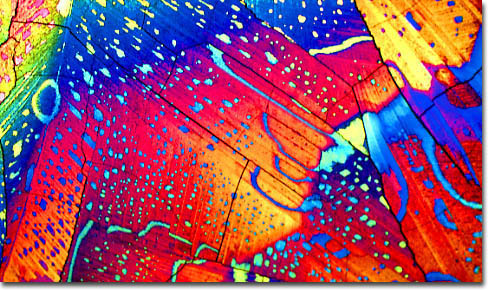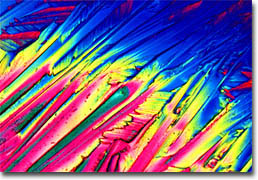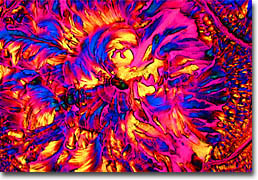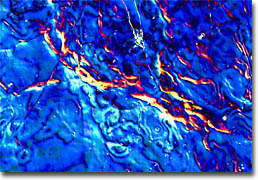The Cocktail Collection

Mint Julep
Like cocktails? Check out our new Cocktail Collection photo gallery.The term alcohol derives from the ancient Arabic word Al-koh'l for a cosmetic, the metallic element antimony that was used in the form of a fine powder to stain eyelids. The word came to refer to any highly refined substance and is now used as a catchall phrase for the large class of organic hydroxyl compounds that we call alcohols. The alcohol that is widely consumed and is known for its intoxicating effects on the human body is ethanol. Although clinically considered a depressant due to its action in suppressing anxiety, this drink has also been documented as having a stimulating effect. It is used as a recreational drink and in some religious rituals throughout the world. Ethanol can be produced in a variety of forms, and wines and beers have been known since before man was literate. Indeed, alcohol was presumably discovered accidentally since any sugar-containing food, such as fruit or honey, may ferment in warm air resulting in alcohol. Upon discovering the unusual effects of the substance, man presumably began a concerted effort in reproducing it, beginning the long history of alcohol manufacture. 
Hot Gin Toddy Sometime after fermentation was discovered to create alcohol, humans found a way to make this alcohol even more potent. Through a process known as distillation, a fermented drink, such as wine or beer, can be utilized to make a substance that has a much higher alcohol content than the original beverage. This process is based on the fact that alcohol (78.5 degrees Celsius) has a lower boiling temperature than water (100 degrees Celsius). If a liquid containing alcohol is heated to a temperature between these two points, therefore, the vapor generated is condensed, and by collecting the condensate, a substance with increased alcohol content may be obtained. Distilled liquors or spirits, as they are often called, were known from at least 800 BC in China, but are not mentioned in Roman documents until about 100 AD. Also, the use of starchy grains instead of grapes, honey, and other sugary substances to create distilled liquors is not believed to have taken place until the Middle Ages. 
Amaretto Distilled alcohol is the backbone of the group of mixed drinks known as cocktails. Gin, whiskey, rum, and vodka are the most widely used spirits to create these popular beverages, which are also characterized by the inclusion of a mixer, such as tonic water, fruit juice, or soda pop. References to cocktails have been found that date back to the early 1800s, and the early use of the term to describe a drink often implied the inclusion of bitters, an ingredient not as popular in modern cocktails. A number of different cocktails were known during the nineteenth century, including the toddy, the highball, the mint julep, and even the Manhattan, a drink reportedly invented per the request of Lady Randolph Churchill, the mother of Sir Winston Churchill. However, the true rise of the cocktail did not occur until the 1920s when Prohibition, which made it illegal to manufacture, transport, or sell alcohol, was instated in the United States. Instead of effectively ridding the country of alcohol, Prohibition actually only decreased the quality of the alcohol that was available, making it wise to disguise the flavor of the bootlegged beverage with juices or other mixers, a practice that became common at speakeasies. 
Cape Codder Though many theories exist regarding the first application of the term cocktail to a mixed drink, no one can be sure which, if any, are true. The conjectures are, nevertheless, quite amusing, since the word seems wholly unsuited to its definition. According to some reports, this seeming incongruity can be explained by the practice of some bartenders placing a feather from a cock's tail in a mixed drink to signal that it contained alcohol, while others contend that the unusual term stemmed from an earlier beverage called "cock's ale" that was consumed during cock fights held in the colonial period. Several more detailed stories regarding the etymology of the word cocktail have also been circulated, many of which are associated with particular taverns, inns, or other establishments that claim to have first used the term. One of the more plausible accounts involves Antoine Amedee Peychaud, the French-born producer of Peychaud Bitters. According to the story, when Peychaud moved to New Orleans and opened up a pharmacy, many of his acquaintances visited the location, where they were served his alcoholic concoctions in a coquetier, the French term for an egg cup. Americans, who would have likely found the French word difficult to pronounce, may have corrupted it into the modern word, cocktail. 
Gin In the United States, cocktails have become increasingly viewed as a kind of appetizer to be enjoyed at the end of the workday before dinner is eaten. Many bars and restaurants even offer specials and discounts on cocktails late in the afternoon when most people are on their way home from work, a timeframe that has come to be known affectionately as "happy hour." This practice is also widespread in a number of other countries, many people of varying cultures finding the consumption of a cocktail a pleasant transition from the stress of the workday to a presumably more relaxing evening. Though enjoyable in moderation, alcohol in the form of cocktails (as well as beer and wine) can often be abused, sometimes leading to alcoholism. It is important, therefore, to be aware of the many effects and attributes of alcohol, in order that it may be consumed in a responsible manner. One should note, for instance, that alcohol remains in the bloodstream for some 18 hours after drinking and is eliminated slowly according to each individual's metabolic characteristics. Also, the rate that an individual absorbs alcohol depends heavily upon the particular drink that is consumed, and those that contain carbonation are usually absorbed more rapidly than those that do not. Thus, cocktails, which often contain carbonated water or some other carbonated beverage, may make one feel intoxicated before he or she would if consuming a different kind of alcoholic drink. |
© 1995-2025 by Michael W. Davidson and The Florida State University. All Rights Reserved. No images, graphics, software, scripts, or applets may be reproduced or used in any manner without permission from the copyright holders. Use of this website means you agree to all of the Legal Terms and Conditions set forth by the owners.
This website is maintained by our
|